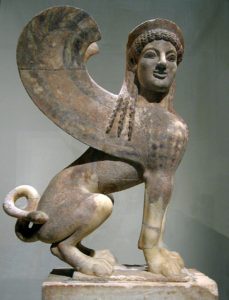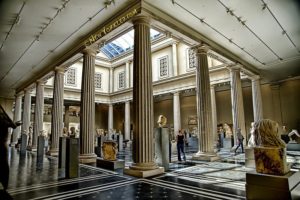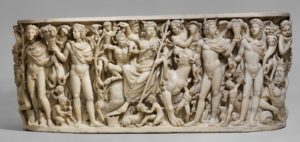Can Greek art still thrill us? After 2,500 years? The Metropolitan Museum of Art is betting that it can, betting about $45 million, in fact – the price tag for the recently unveiled renovated galleries for Greek art.
The centerpiece of these beautiful spaces is a grand vaulted gallery off the main entrance’s Great Hall, a 140-foot-long space which previously functioned mostly as a corridor to the restaurant. For years, visitors on their way to lunch ran a curious gantlet of Cypriot statues – dozens of short, berobed, blank-eyed figures with jutting beards – that were the pride of the museum’s first director, General Luigi Palma di Cesnola.

A marble capital and finial in the form of a sphinx, circa 530 B.C.
The Greek art could be found in adjacent and upstairs galleries that had none of the visibility or polish of the museum’s prized spaces, the kind of galleries where you saw earnest young art students with sketch pads taking measure of torsos and noble heads.
Now, it’s all been dressed up and redesigned with the Met’s usual panache. The great barrel-vaulted, coffered ceiling of the main gallery is itself a thing of beauty, its three skylights reopened after being blacked out during World War II. The light they admit, reflecting off new limestone walls and augmented with recessed spotlights, gives the marble statues an almost magical luminosity.
The six adjacent galleries, three on each side, now opens invitingly through new doorways into the central space, and display the cream of the Met’s collection from the sixth through the fourth centuries B.C. The works, the cleaning of which was a big part of the project, include heroic marble statues and funerary monuments, painted vases and terra cottas, rare bronzes and delicate work in glass and gold. Instead of displaying them in the usual scholarly style – by type and period – many different kinds of objects have been grouped to illustrate themes such as death, warfare, love, and farewells.
The new galleries, and the ones to come, conform closely to the original plans drawn up by the architectural firm McKim, Mead & White in 1912. Visitors now follow a chronological progression beginning with the two galleries for prehistoric and ancient Greek art (these opened in 1996), then through the seven new galleries that just opened. And, when the final phase is completed in several years, the space now occupied by the cafeteria will become the galleries for Roman art, which is where they originally were, and a new restaurant will be built above the Lehman Wing.

Just what is so special about Greek art, that we should be still looking at it near the dawn of the Third Millennium?
The Egyptians were making art long before the Greeks, and, as can be seen in the first galleries, early Greek art looks Egyptian, with its stiff, profiled poses and boxy geometric designs. But it was the Greeks who made the leap into naturalism, and, in their renderings of the human body created an ideal of perfectly balanced proportions that has never been improved upon.
That’s what’s amazing about the Greeks, not only in their art, but in their philosophy, literature, and drama. We are accustomed to the idea of human cultural evolution, of art becoming better and more sophisticated over the centuries, and here, confounding all of that, are these people who seemed to put it all together, all by themselves, in just a century or two.
So, with Greek art, the appeal is in the timelessness, the shock of the old. We say Greek and Roman in the same breath, but the greatest accomplishments of Greek art were five centuries old by the time the Romans started copying them. Its principles resurfaced in the Renaissance about a thousand years after the fall of Rome, and they’ve been with us ever since.
Consider the Athenian Panathenaic amphorae, large vases that were once filled with olive oil and given as prizes to victors in athletic and equestrian contests held in honor of Athena, patron goddess of Athens. Naked runners with powerful horse-like flanks sprint across the pot’s surface, their legs overlapping in a scene that conveys all the animation and excitement of a marathon finish today.
The Euphronios calyx-krater depicts an episode from Homer’s “Iliad” in which Sleep and Death transport the fallen Sarpedon – blood pouring from his wounds – to his native Lycia for burial.

Marble sarcophagus with the Triumph of Dionysos and the Seasons. Roman, circa. A.D. 260–270. Culture: Roman
Many of the marble statues here are actually Roman copies of Greek sculptures, but an intact Greek original in marble, the New York Kouros, dates to about 580 B.C. Its angular body and rigid pose still shows the influence of the Egyptians.
A touching relief, perhaps done by one of the artists who worked on the Parthenon, shows a young girl bidding farewell to her pet doves.
Small fourth-century statuettes represent fashionable women or girls elegantly wrapped in thin cloaks, often wearing sun hats and holding fans. Their naturalness and vitality seems fresh, almost modern, to us today and remind us how open and adept the Greeks were at depicting every side of the human personality.

